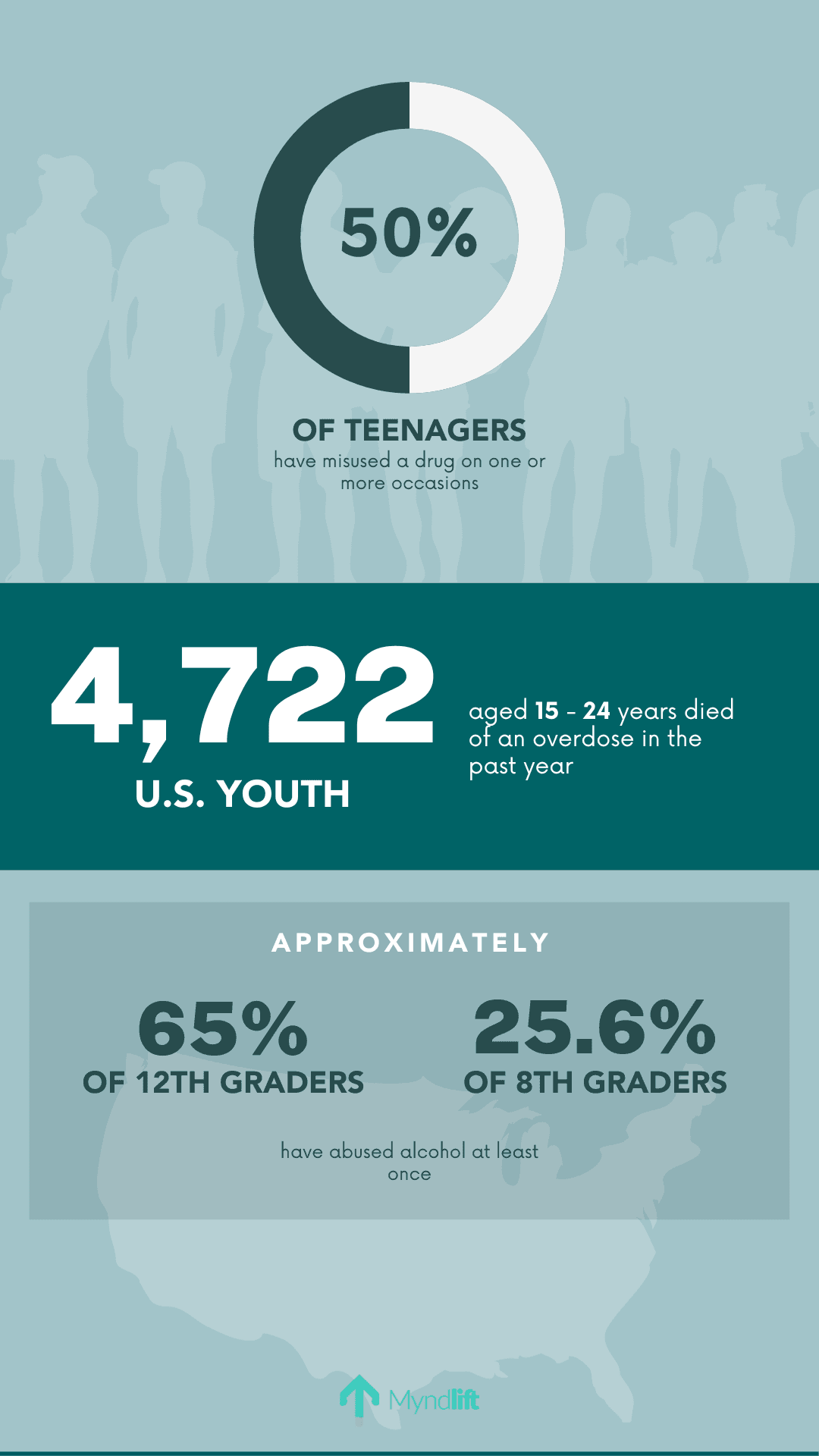No one should have to shoulder the weight of a mental health condition. Yet, the mental health statistics show us that these conditions are affecting more of us than ever before.
In fact, according to this year’s report released by Mental Health America, 21% of U.S. adults are navigating at least one mental illness—the equivalent of around 50 million people.
What’s more, 12.1 million adults are struggling with serious thoughts of suicide. And the mental health statistics in teens seem similarly disheartening.
In this article, we’ll break down the potential causes behind these numbers and explore:
A Snapshot of Mental Health Statistics
The mental health statistics of 2023 illustrate that mental health diagnoses are on the rise, particularly for adults aged 35 to 44. In fact, the prevalence of mental health diagnoses rose from 31% in 2019 to 45% in 2023.

Depression & Suicidal Thoughts Are More Prevalent
The prevalence of depression has risen in both U.S. adults and teens. Recent statistics released from Gallup show that the percentage of U.S. adults with current depression rose from 13.8% in 2020 to 17.8% in 2023.
Approximately 21 million U.S. adults (equivalent to 8.3% of the general population) experienced one or more major depressive episodes in 2023. This is an average across men and women, but individually, these statistics are higher for women (10.3%) than men (6.2%).
Furthermore, according to the mental health statistics in teens, 16% of youth report having had at least one major depressive episode over the past year, compared to 9.7% in 2021.
There was also an increase in suicidal thoughts among adults in 2023, with nearly 2 million more people struggling with this compared to 2021.
Why Are Depression & Suicidal Thoughts More Prevalent?
While it's challenging to pinpoint a single cause for the rising prevalence of severe depression and suicidal thoughts, research highlights certain factors that may be partially responsible for the shift. Some of these factors are:
Poverty: Studies show that depression is more prevalent in people with low socioeconomic status. And even though the statistics for 2023 still haven’t emerged, there was an increase of 1.5 million people living below the poverty line from 2019 to 2022.
Loneliness: A recent report released by the U.S. Surgeon General found that social connection is declining over time, causing the prevalence of loneliness to increase. This trend was already present before the COVID-19 pandemic, but as people were increasingly cut off from support systems and their loved ones during the pandemic, loneliness and isolation intensified.
Chronic Diseases: We’re seeing an increase in chronic diseases within the population. While this is partially due to more people living to old-age, certain risk factors are also partly responsible (poor nutrition, lack of regular exercise, smoking). Chronic diseases are associated with having more depression symptoms, potentially due to the additional challenges and stress having a medical condition brings.
Sedentary Lifestyles: Research indicates that movement is vital for our physical and mental health. Yet, our modern lives are becoming increasingly more sedentary, particularly since the COVID-19 pandemic where we were required to isolate and work from home. And with a sedentary lifestyle, comes an increased risk of depression and anxiety.
Low self-esteem in youth: Today's young people feel more pressure than ever due to social media, where constant comparisons may lead to low self-esteem and a higher risk of depression.
The increase in adults experiencing mental health conditions like Major Depression and substance abuse can have a knock-on effect on their children, creating a web of mental health struggles and substance abuse from generation to generation.
However, there is a ray of hope in the form of mental health treatment. In 2023, significantly more teens with Major Depression received consistent care (40% as opposed to 27% in 2021).
We also saw a slight decrease in the percentage of adults who didn’t receive treatment for a diagnosis (57% in 2021 to 55% in 2023). This suggests that we’re starting to acknowledge the true impact of mental health difficulties and actively support those who are struggling.
Cases of Substance Abuse Are Increasing
In 2021, substance abuse rates in U.S. adults ranged from 7.68% to 8.56%. Today, the rates have doubled, reaching 15%. And if these figures weren’t upsetting enough, approximately 93.5% of these people are receiving no treatment to support them.
Many experts claim that the uncertainty and stress of COVID-19 and the confinement of lockdown may have caused this increase in substance use issues.
And even though the long-term influences of the pandemic are yet to be determined, the Centers for Disease Control and Prevention discovered that 13% of Americans started or increased substance abuse as a result of their emotions around COVID-19.
Drug use in youth, in particular, is seen as a pressing concern, with a minimum of 1 in 8 teenagers using a form of illicit substance in 2023.
Here is a breakdown of some of the key substance abuse statistics in teenagers from 2023:

Recent research suggests the following potential causes of more young people turning to substances:
Using substances as a coping mechanism: Substances are often used as a form of escape and self-medication, so young people may be substituting professional support for anxiety, stress, and other uncomfortable feelings with drugs.
Social conformity: Drugs may provide a short-term reprieve from the insecurities and low self-esteem many of today’s youth experience or become a way to “fit in” in social circles that experiment with substances.
Anxiety Levels Are Going Down Post-Lockdown
Anxiety levels grew exponentially during the COVID pandemic, with an approximate increase of 25%—anxiety disorders affected approximately 374 million people during the pandemic, compared to 298 million people pre-pandemic.
Experts predicted that the prevalence of anxiety disorders would remain elevated after the pandemic.
However, it’s reassuring to see that this hasn’t come to fruition. We’ve seen a slight dip in the number of people with anxiety disorders, with 11% fewer of the U.S. population struggling with anxiety compared to the peak seen in fall 2022.
A Final Word on Mental Health Stats in the U.S.
Current mental health statistics in the U.S. shed light on the challenges many individuals face in our society.
It's crucial to recognize the impact of these issues and work collectively to create a more supportive environment. Whether it's checking in on a friend, fostering open conversations about mental health, or advocating for accessible resources, each of us plays a role.
Let's break the stigma surrounding mental health, support one another, and strive to build a society where mental well-being is a priority. Together, we can make a difference!
Myndlift provides a personalized expert-guided brain training program that can help you elevate your wellbeing by improving your sleep quality, focus, calm, and self-control over mood. Take this 10-second quiz to check if you’re eligible to kick-start your journey for better brain health.
About the author:
Emma Loker
Emma is a practicing trainee Child and Adolescent Psychotherapist studying at the University of Cambridge and a psychology writer with years of experience. She achieved a 1st Class Honors Degree in Psychology from Aston University in Birmingham.
About the checker:
Kaija Sander, Ph.D.
Kaija Sander is a cognitive neuroscientist and scientific consultant for Myndlift. She holds a BSc in Biomedical Science with a specialization in Neuroscience and Mental Health from Imperial College London and a PhD in Neuroscience from McGill University. Her doctoral research focused on brain connectivity relating to second language learning success. She is passionate about the broader applications of science to have a positive impact on people’s lives.
References
American Psychological Association. (n.d.). Stress in America 2023. https://www.apa.org/news/press/releases/stress/2023/collective-trauma-recovery#:~:text=Further%2C%20there%20was%20a%20significant,31%25
Bustamante, J. (2023, January 1). Substance Abuse and Addiction Statistics [2023]. NCDAS. https://drugabusestatistics.org/#:~:text=9.5%20million%20or%203.8%25%20of,marijuana%20and%20prescription%20pain%20relievers.
Bustamante, J. (2023, January 1). Teenage Drug Use Statistics [2023]: Data & Trends on abuse. NCDAS. https://drugabusestatistics.org/teen-drug-use/
Centers for Disease Control and Prevention. (2023, April 25). About Mental Health. https://www.cdc.gov/mentalhealth/learn/index.htm#:~:text=Mental%20illnesses%20are%20among%20the,a%20seriously%20debilitating%20mental%20illness.
Cigna (2020). Loneliness and the Workplace: 2020 U.S. Report. https://legacy.cigna.com/static/www-cigna-com/docs/about-us/newsroom/studies-and-reports/combatting-loneliness/cigna-2020-loneliness-report.pdf
Clary, B., & Gawthrop, E. (2023, May 12). Anxiety, depression rates stay high as COVID emergencies end. MPR News. https://www.mprnews.org/story/2023/05/12/anxiety-depression-rates-stay-high-as-covid-emergencies-end
Czeisler, M. É., Lane, R. I., Petrosky, E., Wiley, J. F., Christensen, A., Njai, R., Weaver, M. D., Robbins, R., Facer-Childs, E. R., Barger, L. K., Czeisler, C. A., Howard, M., & Rajaratnam, S. M. W. (2020). Mental health, substance use, and suicidal ideation during the COVID-19 pandemic — United States, June 24–30, 2020. Morbidity and Mortality Weekly Report, 69(32), 1049–1057. https://doi.org/10.15585/mmwr.mm6932a1
Hanna, F., You, E., & Elsherif, M. (2023). Editorial: The impact of sedentary behavior and virtual lifestyle on physical and mental wellbeing: social distancing from healthy living. Frontiers in Public Health, 11. https://doi.org/10.3389/fpubh.2023.1265814
Hidaka, B. H. (2012). Depression as a disease of modernity: Explanations for increasing prevalence. Journal of Affective Disorders, 140(3), 205–214. https://doi.org/10.1016/j.jad.2011.12.036
Huang, D., Wang, J., Fang, H., Fu, Y., & Lou, J. (2023). Longitudinal association of chronic diseases with depressive symptoms in middle-aged and older adults in China: Mediation by functional limitations, social interaction, and life satisfaction. Journal of global health, 13, 04119. https://doi.org/10.7189/jogh.13.04119
Kneebone, E., & Berube, A. (2023, October 11). Post-pandemic poverty is rising in America’s suburbs. Brookings. https://www.brookings.edu/articles/post-pandemic-poverty-is-rising-in-americas-suburbs/#:~:text=According%20to%20the%20latest%20ACS,pandemic%20struck%20(Figure%201).
Mental Health America. (n.d.). Anxiety. https://mhanational.org/conditions/anxiety#:~:text=Anxiety%20disorders%20are%20among%20the,these%20debilitating%20illnesses%20each%20year.
National Institute of Mental Health (NIMH). (n.d.). Major Depression. https://www.nimh.nih.gov/health/statistics/major-depression
Nawi, A. M., Ismail, R., Ibrahim, F., Hassan, M. R., Manaf, M. R. A., Amit, N., Ibrahim, N., & Shafurdin, N. S. (2021). Risk and protective factors of drug abuse among adolescents: a systematic review. BMC Public Health, 21(1). https://doi.org/10.1186/s12889-021-11906-2
Office of the Surgeon General (OSG). (2023). Our Epidemic of Loneliness and Isolation: The U.S. Surgeon General’s Advisory on the Healing Effects of Social Connection and Community. US Department of Health and Human Services. https://www.hhs.gov/sites/default/files/surgeon-general-social-connection-advisory.pdf
Orth, U., Robins, R. W., & Roberts, B. W. (2008). Low self-esteem prospectively predicts depression in adolescence and young adulthood. Journal of Personality and Social Psychology, 95(3), 695–708. https://doi.org/10.1037/0022-3514.95.3.695
Raghupathi, W., & Raghupathi, V. (2018). An Empirical Study of Chronic Diseases in the United States: A Visual Analytics Approach. International journal of environmental research and public health, 15(3), 431. https://doi.org/10.3390/ijerph15030431
Reinert, M., Fritze, D., & Nguyen, T. (2023, October). The State of Mental Health in America 2023. Mental Health America. https://mhanational.org/sites/default/files/2023-State-of-Mental-Health-in-America-Report.pdf
Reinert, M., Fritze, D., & Nguyen, T. (2020, October 20). The State of Mental Health in America 2021. Mental Health America. https://mhanational.org/sites/default/files/2021%20State%20of%20Mental%20Health%20in%20America_0.pdf
Ridley, M., Rao, G., Schilbach, F., & Patel, V. (2020). Poverty, depression, and anxiety: Causal evidence and mechanisms. Science (New York, N.Y.), 370(6522), eaay0214. https://doi.org/10.1126/science.aay0214
Rusby, J. C., Light, J. M., Crowley, R., & Westling, E. (2018). Influence of parent–youth relationship, parental monitoring, and parent substance use on adolescent substance use onset. Journal of Family Psychology, 32(3), 310–320. https://doi.org/10.1037/fam0000350
Santomauro, D., Herrera, A. M. M., Shadid, J., Zheng, P., Ashbaugh, C., Pigott, D. M., Abbafati, C., Adolph, C., Amlag, J. O., Aravkin, A. Y., Bang-Jensen, B., Bertolacci, G. J., Bloom, S. S., Castellano, R., Castro, E., Chakrabarti, S., Chattopadhyay, J., Cogen, R. M., Collins, J. K., . . . Ferrari, A. J. (2021). Global prevalence and burden of depressive and anxiety disorders in 204 countries and territories in 2020 due to the COVID-19 pandemic. The Lancet, 398(10312), 1700–1712. https://doi.org/10.1016/s0140-6736(21)02143-7
Stults‐Kolehmainen, M. (2023). Humans have a basic physical and psychological need to move the body: Physical activity as a primary drive. Frontiers in Psychology, 14. https://doi.org/10.3389/fpsyg.2023.1134049
Subirón-Valera, A. B., Rodríguez-Roca, B., Calatayud, E., Gómez-Soria, I., Andrade-Gómez, E., & Marcén-Román, Y. (2023). Linking sedentary behavior and mental distress in higher education: a cross-sectional study. Frontiers in Psychology, 14. https://doi.org/10.3389/fpsyg.2023.1205837
The Cigna Group Newsroom. (n.d.). The Loneliness Epidemic Persists: A Post-Pandemic Look at the State of Loneliness among U.S. Adults. https://newsroom.thecignagroup.com/loneliness-epidemic-persists-post-pandemic-look
Withers, D. (2023, May 17). U.S. Depression Rates Reach New Highs. Gallup. https://news.gallup.com/poll/505745/depression-rates-reach-new-highs.aspx





